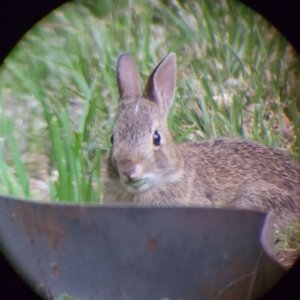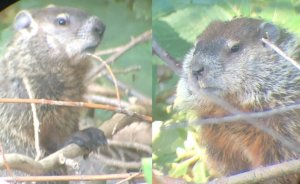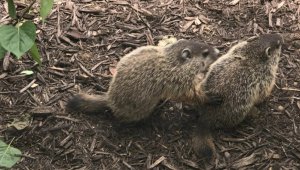Backyard babies: Cottontails, groundhogs, and skunks – oh my!
May 1, 2024
Ali Groulx, Park Interpreter
“Be careful,” he told me, “We do not want to scare them.” My father had stumbled upon a shallow hole in the ground lined with grasses. Six little lumps that reminded me of fuzzy kiwi fruits were laid there. “I found a bunny nest,” he tells me. Instinctively, I reached my hands out. “Do not touch them!” my mom cried, “Their mother will abandon them if they smell like you!” At the time I was young, but I understood the implications. The bunnies still needed their mother, for they had yet to even open their eyes. Bunny time moves a lot faster than human time, however. Bunny mothers only carry their young for a month before giving birth, and her babies will venture out of the nest only two weeks afterwards. Cottontail rabbits reproducing at an extreme rate is not just a trope; bunny babies will start their own families once they hit the ripe old age of 3 months.

Many understand that once a human has touched a wild animal baby, their mother will abandon them, though this is not entirely true. While humans should avoid touching wildlife, especially wild babies, it is for a different reason; us large, towering humans could scare the younglings, causing them to flee and putting them in danger of getting lost or eaten. Learning how to deal with their new existence can be difficult. Babies who fully depend on their mothers’ care are called altricial. A human baby is altricial, born fully dependent on their caregivers, as are baby bunnies. The success of the litter depends on the resilience and ‘street-smarts’ of their mother, all of which is an instinct honed over many millennia. Human action or inaction also has an impact on new life, whether it be helping a plant ‘mom’ disperse seeds or deterring a family of groundhogs determined to eat every plant that you confidently thought they would avoid. Nature tends to be amusing in that way.
When spring arrived last year, we anticipated the emergence of our resident backyard groundhog, named “Chog.” Through April, I watched her waddle from her burrow to chomp on grass and survey for other food sources. I figured out her routine –chomp, sunbathe, chomp, sleep, repeat. One morning in late May, I gazed out upon her favorite sunbathing mound and saw her, but something was off.

I thought I was going crazy as I tried to determine how she magically shrunk three sizes overnight, but then, another head popped up above the forbs, then another, and finally a fourth.
You have got to be kidding me, I thought. My grizzled, scar faced Chog was raising not one, but FOUR baby groundhogs, called chucklings. I felt so proud of her, yet a little distressed. This was the year I wanted to start planting more around our new home, and that plan was going to need some serious adjusting.
Groundhogs give birth around April, and their young start following their mother out of the burrow at 6 weeks old. They followed Mother Chog closely as she guided them to her favorite haunts – dodging, dipping, and prairie-dogging at any sound or movement that concerned them. Once, I noticed that the white mulberry tree in our front yard was mysteriously bare, the branches bowing with the weight of three chucklings – 2 pounds each. The babies climbed the tree to eat straight from the source, and they were very messy. Mother Chog was hanging out underneath with the fourth baby, eating the berries that showered them. I could not help myself; I became invested. Mother Chog’s family lost two babies by midsummer. Where they went or who they were eaten by, I was unsure. The remaining two chucklings wrestled and climbed up trees as their mother lay sunbathing, flicking off flies as they landed on her gluttonous figure. Her babies will not grow to be her size until their third summer. So far, I have not seen Chog this spring and suspect she didn’t make it through the winter. Her work was done, though. She prepared her babies for life without her.

Baby skunks learn like groundhogs do. Teaching them food-finding skills is solely up to their mother. Another important part of being a kit, or baby skunk, involves learning how to properly use their defenses. A skunk’s striped black and white coat already signals danger, but this alone will not keep them from harm. The scent glands of a baby skunk will not be ready to spray until they are older, giving them a few months to refine their technique. Turning their bodies into the letter ‘U’ comes naturally but they must perfect a stomping dance before utilizing their ultimate weapon, for a skunk cannot spray all willy-nilly; the strongly-scented oils they produce need time to recharge after use. The little skunks bound and hop around the yard, following behind their mother in a straight line. You can watch a video of a rehabbed baby skunk learning to stomp here. The boys will leave the family before the start of fall and their sisters will stay with their mother until the next spring, when they will wander off to begin their own skunk families, passing down the knowledge gifted to them by their mother.
The compassion that we possess is well used towards animal mothers and their young. It can be an honor to have a yard that is deemed safe enough for bunnies, groundhogs, or skunks to raise a family. Although animals like groundhogs can cause a bit of destruction when it comes to plants, mindful consideration can reduce the animosity caused by ravenous babies. Remember to check before mowing or trimming and stay calm and quiet whenever around a nest of animal youngsters. Even though they cannot express it themselves, your effort to protect animal mothers and their babies holds worth. As baby season progresses, keep an eye open for these three animal families. You will marvel at the progress and growth they achieve each day!
SOURCES:
Mammals of the Great Lakes Region by Allen Kurta
The World of the Woodchuck by W.J. Schoonmaker
